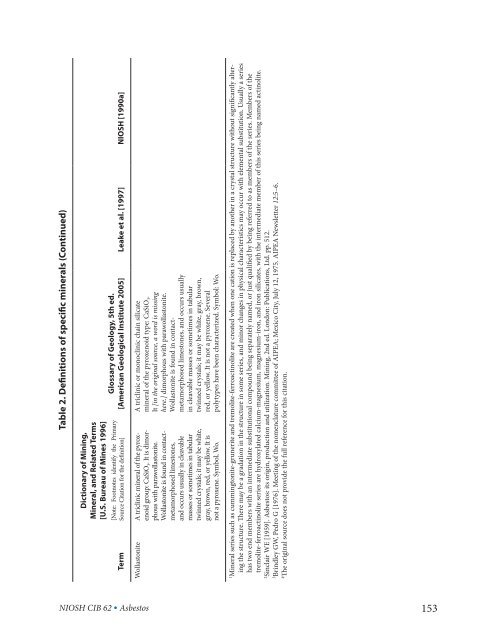Asbestos Fibers and Other Elongate Mineral Particles: State of the ...
Asbestos Fibers and Other Elongate Mineral Particles: State of the ...
Asbestos Fibers and Other Elongate Mineral Particles: State of the ...
- No tags were found...
You also want an ePaper? Increase the reach of your titles
YUMPU automatically turns print PDFs into web optimized ePapers that Google loves.
Table 2. Definitions <strong>of</strong> specific minerals (Continued)<br />
Glossary <strong>of</strong> Geology, 5th ed.<br />
[American Geological Institute 2005] Leake et al. [1997] NIOSH [1990a]<br />
Dictionary <strong>of</strong> Mining,<br />
<strong>Mineral</strong>, <strong>and</strong> Related Terms<br />
[U.S. Bureau <strong>of</strong> Mines 1996]<br />
[Note: Footnotes identify <strong>the</strong> Primary<br />
Source Citation for <strong>the</strong> definition]<br />
Term<br />
NIOSH CIB 62 • <strong>Asbestos</strong><br />
A triclinic or monoclinic chain silicate<br />
mineral <strong>of</strong> <strong>the</strong> pyroxenoid type: CaSiO3. It [in <strong>the</strong> original source, a word is missing<br />
here.] dimorphous with parawollastonite.<br />
Wollastonite is found in contactmetamorphosed<br />
limestones, <strong>and</strong> occurs usually<br />
in cleavable masses or sometimes in tabular<br />
twinned crystals; it may be white, gray, brown,<br />
red, or yellow. It is not a pyroxene. Several<br />
polytypes have been characterized. Symbol: Wo.<br />
Wollastonite A triclinic mineral <strong>of</strong> <strong>the</strong> pyroxenoid<br />
group: CaSiO3. It is dimorphous<br />
with parawollastonite.<br />
Wollastonite is found in contactmetamorphosed<br />
limestones,<br />
<strong>and</strong> occurs usually in cleavable<br />
masses or sometimes in tabular<br />
twinned crystals; it may be white,<br />
gray, brown, red, or yellow. It is<br />
not a pyroxene. Symbol, Wo.<br />
1<strong>Mineral</strong> series such as cummingtonite-grunerite <strong>and</strong> tremolite-ferroactinolite are created when one cation is replaced by ano<strong>the</strong>r in a crystal structure without significantly altering<br />
<strong>the</strong> structure. There may be a gradation in <strong>the</strong> structure in some series, <strong>and</strong> minor changes in physical characteristics may occur with elemental substitution. Usually a series<br />
has two end members with an intermediate substitutional compound being separately named, or just qualified by being referred to as members <strong>of</strong> <strong>the</strong> series. Members <strong>of</strong> <strong>the</strong><br />
tremolite-ferroactinolite series are hydroxylated calcium-magnesium, magnesium-iron, <strong>and</strong> iron silicates, with <strong>the</strong> intermediate member <strong>of</strong> this series being named actinolite.<br />
2Sinclair WE [1959]. <strong>Asbestos</strong>: its origin, production <strong>and</strong> utilization. Mining, 2nd ed. London: Publications, Ltd. pp. 512.<br />
3Brindley GW, Pedro G [1976]. Meeting <strong>of</strong> <strong>the</strong> nomenclature committee <strong>of</strong> AIPEA; Mexico City, July 12, 1975. AIPEA Newsletter 12:5–6.<br />
4 The original source does not provide <strong>the</strong> full reference for this citation.<br />
153

















